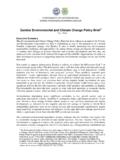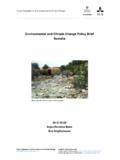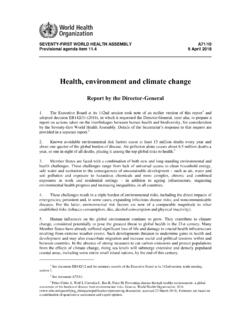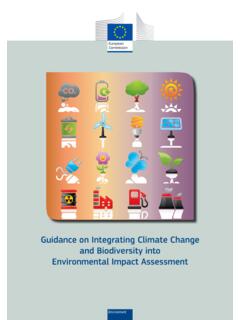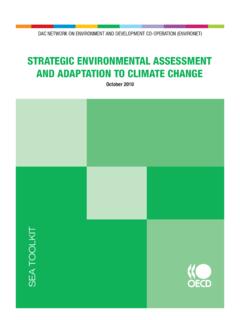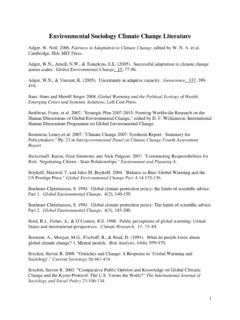Transcription of Environmental and Climate Change Policy Brief Zimbabwe
1 Sida's Helpdesk for Environment and Climate Change Contact: Gunilla lund Wingqvist Team Leader: Anders Ekbom Quality Manager: Eva Stephansson Environmental and Climate Change Policy Brief Zimbabwe Photo from 2016-04-13 Ulrika kesson, Gunilla lund Wingqvist G ran Ek Emelie C sar ii Executive Summary This Environmental and Climate Change Policy Brief will inform Sweden s cooperation strategy process and provide analytic input to Sida s preparation of a new strategy proposal for cooperation with Zimbabwe (2016-2020). It is foreseen that the future cooperation shall focus on improved environment, limited Climate impact, and strengthened resilience against Environmental degradation, Climate Change and natural disasters, as one out of three areas.
2 The Policy Brief aims at presenting key Environmental sustainability challenges and opportunities in Zimbabwe , their linkages to poverty reduction and socio-economic development. The assignment was conducted as a desk-study, based on available reports, research papers and statistics. The lack of updated environment statistics is a major challenge in Zimbabwe and should be considered when reading this Policy Brief . The main Environmental challenges facing Zimbabwe are: land degradation, deforestation, inadequate quantity and quality of water resources, air pollution, habitat destruction and loss of biodiversity, waste (including toxic waste), natural hazards (mainly recurring droughts), and Climate Change (including rainfall variability and seasonality). Two main issues that stand out are the country s challenge in facing Climate Change - General Circulation Models (GCM) indicate that most of Southern Africa, including Zimbabwe1, is likely to experience temperatures 2-4o C higher in this century compared to the 1961-1990 average and unregulated infrastructural development and land use that contribute to deforestation, land degradation and habitat fragmentation.
3 The poverty is widespread in Zimbabwe and it is estimated that the average poverty rate exceeded 72% of the total population. In rural areas a third of the population live in extreme poverty. Manifestations of poverty in Zimbabwe include inadequate access to natural resources, including water and land, malnutrition, un-, or underemployment, unequal access to good-quality education, and lack of agricultural inputs. Climate variability and Change with increased intensity and frequency of droughts and floods, negative impacts on economy, and a high prevalence of HIV/AIDS, are other factors that enhance poverty. Zimbabwe s economy is natural resource-based and depends heavily on agriculture and mining. The potential for economic growth in Zimbabwe is closely linked with development of its natural resources including land, biodiversity and minerals.
4 The Policy frameworks and the institutional set-up for managing Environmental challenges in Zimbabwe , with a few exceptions, seem quite robust. The main problem relates to implementation and enforcement of existing legislation and policies, further hampered by a lack of good governance, including lack of transparency and accountability, and weak coordination and cross-sectoral cooperation. Integration of Environmental concerns in plans and strategies, poor capacity and coordination among law enforcement agencies, highly sectoral and compartmentalised understanding of development issues and a perceived lack of transparency and political will to enforce the laws etc., are all challenges to Environmental sustainability in Zimbabwe . Based on the findings in this Brief , the Helpdesk suggest the following areas to serve as ideas for further discussions: agriculture, water, Climate Change adaptation, biodiversity and 1 Ujeneza Eva L , Babatunde J.
5 Abiodun (2015): iii ecosystem services, tourism, forestry, mining, human rights, environment management, disaster risk management and resilience, renewable energy as well as green economy. Given Sida s experience from and strong commitment to rural electrification in the Power Africa programme interventions in the energy and Climate Change sectors could be seen as areas where a Swedish added value could benefit the development cooperation activities in Zimbabwe . But as the authors of the Policy Brief are not as close to the Zimbabwean development context as the staff at the Harare embassy and Africa department at Sida HQ we have not delved further into pointing out particular focus areas for Swedish interventions. The environment is inseparable from the economy, poverty, health, livelihoods and food security, which is why it is important for Zimbabwe to address its Environmental challenges.
6 With the abundant natural resources in Zimbabwe , including land, biodiversity and minerals, there is a great potential for economic development and eventually poverty reduction if these resources are used in an environmentally sustainable way. iv Contents Executive Summary .. ii 1. Introduction .. 5 2. Key Environmental problems, their causes and opportunities .. 5 3. What are the effects of the Environmental problems? .. 8 Impacts on Poverty .. 8 Impacts on Public Health .. 10 Impacts on Economic development .. 12 4. Policy framework and institutional capacity for managing Environmental challenges .. 14 Integration of environment in the Policy framework .. 14 Governance, implementation and enforcement .. 16 5. Other issues .. 17 Green economy - Lessons learnt from green economy/green growth strategies in Kenya, South Africa and Ethiopia.
7 17 Sustainable energy .. 19 Zimbabwe s Intended Nationally Determined Contribution .. 20 Sustainable Development Goals .. 20 Human rights and environment & Climate Change .. 22 6. Risks and opportunities .. 23 Risks .. 23 Opportunities .. 24 7. Conclusions .. 25 Ongoing Swedish support related environment and Climate Change .. 25 Issues for Sida to consider .. 26 References .. 31 Websites .. 32 Annex .. 35 Annex 1. Impacts of natural hazards in Zimbabwe .. 35 Annex 2. South African Green Economy Strategy .. 36 Annex 3. Example of initiative to provide economic incentives for local communities in wildlife conservation .. 37 5 1. Introduction The Swedish Government has identified environment and Climate Change as one of three thematic priorities for development cooperation2.
8 This is reinforced by the Aid Policy Framework (2014), which states that Environmental and Climate Change aspects are a central point of departure for all Swedish development cooperation. An analysis of Environmental and Climate Change aspects constitutes an important basis for a well-informed strategy process. This Environmental and Climate Change Policy Brief will inform Sweden s cooperation strategy process and provide analytic input to Sida s preparation of a new strategy proposal for cooperation with Zimbabwe (2016-2020). While the formal instructions have not yet been provided by the Swedish government, it is foreseen that the future cooperation shall focus on the following areas: improved environment, limited Climate impact, and strengthened resilience against Environmental degradation, Climate Change and natural disasters, specifically generation of, and access to, sustainable energy, and the contribution of a green economy to productive employment and entrepreneurship; strengthened democracy, gender equality, and increased respect for human rights; improved basic health.
9 The purpose of the Policy Brief is to give the Embassy of Sweden in Zimbabwe an overview of the strategic issues to consider with regards to environment and Climate Change . It aims at briefly presenting key Environmental sustainability challenges and opportunities in Zimbabwe , their linkages to poverty reduction and socio-economic development, in the context of the given entry points and areas of cooperation for Swedish development cooperation in Zimbabwe . The Policy Brief was conducted as a desk-study in February 2016, based on available reports, research papers and statistics. The lack of updated environment statistics is a major challenge in Zimbabwe and should be considered when reading this Policy Brief . The ongoing preparations of Zimbabwe s fourth state of the environment report might provide a better insight in terms of trends and status of the sector for better planning and management purposes but it remains to be 2.
10 Key Environmental problems, their causes and opportunities Zimbabwe , a landlocked, tropical country in southern Africa, has abundant natural resources including land, biodiversity, and minerals. After South Africa, Zimbabwe is the most industrialised country in the SADC region, with a majority of the industries situated around the major cities. Mining and agriculture are the most significant economic sectors. The country produces over 35 different minerals in over 1,000 mines4. 2 Government communication 2013/14:131, Aid Policy Framework the direction of Swedish Aid 3 UNCT and Gov of Zim (2014) 4 Spong et al. (undated) 6 Zimbabwe is a semi-arid country with limited water resources. Although it shares one of the world s greatest water bodies, the Zambezi River5, it does not currently supply water to the rest of the country, which is water-scarce in most parts.
